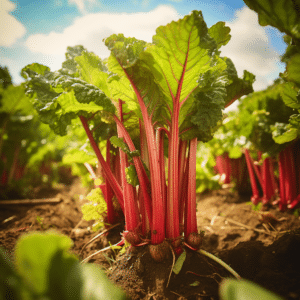Rhubarb is a perennial vegetable that is easy to grow and requires minimal maintenance. It is known for its tart flavor and is commonly used in pies, jams, and desserts. In this guide, we will walk you through the process of growing rhubarb in your own garden.
Understanding Rhubarb

Rhubarb is a hardy plant that thrives in cooler climates. It is usually grown for its stalks, which are harvested in the spring and early summer. The leaves of the rhubarb plant are toxic and should not be consumed.
There are several varieties of rhubarb available, each with its own unique flavor and color. Some of the most popular varieties include ‘Victoria’, ‘Canada Red’, and ‘Crimson Red’. Choosing the right variety for your garden depends on your personal taste and the climate in your area.
The Life Cycle of Rhubarb
Rhubarb is a perennial plant, meaning it can live for several years. It typically starts growing in early spring, with the stalks ready for harvest by late spring or early summer. After harvesting, the plant will continue to grow until the first frost, when it will go dormant for the winter.
It’s important to note that rhubarb plants should not be harvested in their first year. This allows the plant to establish a strong root system. From the second year onwards, you can start harvesting the stalks.
Planting Rhubarb

Planting rhubarb is a straightforward process. The best time to plant rhubarb is in early spring, as soon as the ground can be worked. Rhubarb can be grown from seeds, but it’s more common to plant rhubarb crowns, which are the dormant roots of the plant.
Choose a sunny location for your rhubarb plants, as they need at least six hours of sunlight each day. The soil should be well-draining and rich in organic matter. If your soil is heavy clay or sandy, you can improve it by adding compost or well-rotted manure.
How to Plant Rhubarb Crowns
Start by digging a hole that is wide and deep enough to accommodate the rhubarb crown. The top of the crown should be level with or slightly below the soil surface. Place the crown in the hole and backfill with soil, firming it gently around the crown.
Space the rhubarb crowns about 3 to 4 feet apart. This gives the plants plenty of room to grow and ensures good air circulation, which helps prevent disease. After planting, water the crowns thoroughly.
Caring for Rhubarb
Rhubarb is a low-maintenance plant, but there are a few things you can do to ensure a healthy and productive crop. Regular watering is essential, especially during dry periods. Rhubarb plants also benefit from an annual application of compost or well-rotted manure.
While rhubarb is a hardy plant, it can be affected by pests and diseases. Common pests include slugs and snails, which can be controlled with organic slug pellets or beer traps. Diseases such as crown rot and leaf spot can be prevented by practicing good garden hygiene and crop rotation.
Harvesting Rhubarb

Harvesting rhubarb is a simple process. Simply grasp the stalk near the base and pull it away from the plant with a gentle twist. Never harvest all the stalks from a plant at once; leave at least two stalks per plant to ensure it continues to grow.
The best time to harvest rhubarb is in the spring and early summer, when the stalks are 12 to 18 inches long. The stalks should be firm and the leaves fully expanded. Remember, only the stalks are edible; the leaves should be removed and discarded.
Using and Storing Rhubarb
Rhubarb is a versatile ingredient that can be used in a variety of dishes. It’s most commonly used in desserts, such as pies and crumbles, but it can also be used in savory dishes. Rhubarb can be eaten raw, but it’s usually cooked to soften its tart flavor.
Rhubarb can be stored in the refrigerator for up to two weeks. It can also be frozen for longer storage. To freeze rhubarb, simply wash the stalks, cut them into 1-inch pieces, and freeze them in a single layer on a baking sheet. Once frozen, transfer the rhubarb pieces to a freezer bag or container.
Rhubarb Recipes
There are countless ways to use rhubarb in your kitchen. From classic rhubarb pie to rhubarb jam, the possibilities are endless. Here are a few recipes to get you started:
- Rhubarb Pie
- Rhubarb Jam
- Rhubarb Crumble
- Rhubarb Sauce
As you can see, growing rhubarb is a rewarding endeavor. With a little care and attention, you can enjoy a bountiful harvest of this versatile vegetable. Happy gardening!